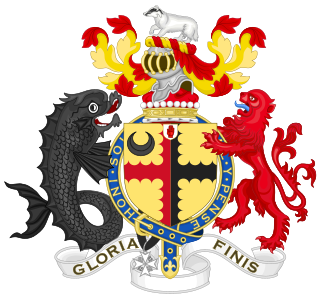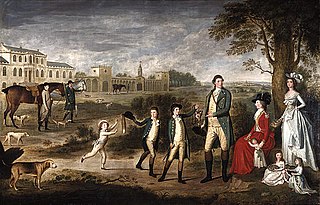Related Research Articles

Baron FitzWalter is an ancient title in the Peerage of England. It was created on 24 June 1295 for Robert FitzWalter. The title was created by writ, which means that it can descend through both male and female lines.

Viscount Brookeborough, of Colebrooke in the County of Fermanagh, is a title in the Peerage of the United Kingdom. It was created in 1952 for the Ulster Unionist politician and Prime Minister of Northern Ireland, Captain The Rt. Hon. Sir Basil Brooke, 5th Bt., P.C. (N.I.), M.P.

Baron Brownlow, of Belton in the County of Lincoln, is a title in the Peerage of Great Britain. It was created in 1776 for Sir Brownlow Cust, 4th Baronet. The Cust family descends from Richard Cust (1622-1700) of The Black Friars, Stamford, who represented Lincolnshire and Stamford in Parliament. In 1677 he was created a baronet, "of Stamford in the County of Lincoln". He was succeeded by his grandson Richard Cust, 2nd Baronet, who married Anne Brownlow, daughter of Sir William Brownlow, 4th Baronet, "of Humby", Lincolnshire, and sister and sole heiress of John Brownlow, 1st Viscount Tyrconnel, 5th Baronet of Belton House, Lincolnshire. The 2nd Baronet's son Sir John Cust, 3rd Baronet, sat as a Member of Parliament for Grantham and served as Speaker of the House of Commons from 1761 to 1770 and in 1754 inherited the Brownlow estates, including Belton, on the death of his childless maternal uncle Viscount Tyrconnel. His son Brownlow Cust, 4th Baronet, represented Ilchester, Somerset, and Grantham in Parliament and in 1776 was raised to the peerage as Baron Brownlow, "of Belton in the County of Lincoln", chiefly in recognition of his father's services. He was succeeded by his son John Cust, 2nd Baron Brownlow, who had sat as a Member of Parliament for Clitheroe, Lancashire, and also served as Lord Lieutenant of Lincolnshire for many years. In 1815 he was created Viscount Alford, "in the County of Lincoln", and Earl Brownlow, both in the Peerage of the United Kingdom. In 1810 the future 1st Earl had married Sophia Hume, a daughter of Sir Abraham Hume, 2nd Baronet, of Wormleybury, by his wife Lady Amelia Egerton, a great-granddaughter of John Egerton, 3rd Earl of Bridgewater.

Baron Muskerry is a title in the Peerage of Ireland. It was created in 1781 for Sir Robert Deane, 6th Baronet. He had previously represented County Cork in the Irish House of Commons.

Marquess of Ripon, in the County of York, was a title in the Peerage of the United Kingdom. It was created in 1871 for the Liberal politician George Robinson, 2nd Earl of Ripon.

There have been five baronetcies of the United Kingdom created for a person with the surname Erskine, two in the Baronetage of Nova Scotia, one in the Baronetage of Great Britain and two in the Baronetage of the United Kingdom. Two of the creations are extant as of 2010.
The Ashburnham Baronetcy, of Broomham in the County of Sussex, is a title in the Baronetage of England. It was created on 15 May 1661 for Denny Ashburnham, Member of Parliament for Hastings. He was the grandson of Adam Ashburnham, Member of Parliament for Winchelsea in 1592, who was the son of Laurence Ashburnham, and a descendant of Richard Ashburnham of Broomham, second son of Thomas Ashburnham, whose eldest son John was the ancestor of the Earls of Ashburnham. He was succeeded by his elder son, William, the second Baronet. He represented Hastings and Seaford in the House of Commons. He died childless in 1755 and was succeeded by his younger brother, Charles, the third Baronet. His son, William, the fourth Baronet, was Bishop of Chichester. On his death the title passed to his son, the fifth Baronet. He sat as Member of Parliament for Hastings.

The Adams Baronetcy, of London, was a title in the Baronetage of England. It was created on 13 June 1660 for Thomas Adams, Lord Mayor of London in 1645. The title presumably became extinct on the death of the sixth baronet in 1770.
There have been two baronetcies created for people with the surname Jenkinson, both in the Baronetage of England. The seventh holder of the first creation was elevated to the peerage as Earl of Liverpool in 1796, a title which became extinct in 1851.
There have been four baronetcies for persons with the surname Blake, one in the Baronetage of Ireland, two in the Baronetage of Great Britain and one in the Baronetage of the United Kingdom. Two of the creations are extant as of 2010. The Blake Baronetcy, of Menlough in the County of Galway, was created in the Baronetage of Ireland on 10 July 1622 for Valentine Blake, Mayor of Galway in 1611 and 1630 and a member of the Irish House of Commons for County Galway. His grandfather Thomas Blake had preceded him as Mayor. The second Baronet was a member of the Irish Parliament for Galway Borough. The third Baronet represented both County Galway and Galway Borough in Parliament. The sixth Baronet was a member of the Irish House of Commons for County Galway. He was the first Catholic gentlemen of distinction to join William of Orange. The twelfth Baronet represented Galway Borough in the British House of Commons. The fourteenth Baronet was high sheriff of County Galway in 1872. See also the Blake Baronetcy of Twizell Castle below.
The Bridges Baronetcy, of Goodnestone in the County of Kent, was created in the Baronetage of Great Britain on 19 April 1718 for Brook Bridges. His son the second Baronet, died in 1733 whilst in office as High Sheriff of Kent. His grandson, the third Baronet, represented Kent in the House of Commons. In 1842, the fifth Baronet, unsuccessfully claimed the ancient barony of FitzWalter as a descendant of Mary, sister of the seventeenth Baron FitzWalter. He later sat as a Member of Parliament for Kent East. In 1868 he was created Baron FitzWalter, of Woodham Walter in the County of Essex, in the Peerage of the United Kingdom. However, the peerage became extinct on his death, while he was succeeded in the baronetcy by his younger brother, the sixth Baronet. On his death the title passed to his first cousin, the seventh Baronet. He was the son of Reverend Brook Henry Bridges, third son of the third Baronet. When he died this line of the family also failed and the title was passed on to his first cousin, the eighth Baronet. He was the son of Reverend Brook Edward Bridges, fourth son of the third Baronet. He never married and on his death in 1899 the baronetcy became extinct.
There have been five baronetcies created for persons with the surname Ward, one in the Baronetage of England, one in the Baronetage of Ireland and three in the Baronetage of the United Kingdom. See also Warde baronets.
There have been two baronetcies created for persons with the surname Bethune, one in the Baronetage of Nova Scotia and one in the Baronetage of the United Kingdom.
Sir Thomas Pym Hales, 4th Baronet, of Beakesbourne in Kent, was an English member of parliament.
There have been three baronetcies created for persons with the surname Dryden, one in the Baronetage of England and two in the Baronetage of Great Britain. Two of the creations are extant and are joined under a single holder since 1874.
There have been two baronetcies created for persons with the surname Dyer, both in the Baronetage of England. One creation is extant as of 2015.
There have been three baronetcies created for persons with the surname Foulis, one in the Baronetage of England and two in the Baronetage of Nova Scotia.

There have been three baronetcies created for members of the Sedley family of Kent, all in the Baronetage of England. All three creations are extinct.

The Hewet Baronetcy, of Headley Hall in the County of York, was a title in the Baronetage of England. It was created on 11 October 1621 for John Hewet. The title became extinct on the death of the eighth Baronet in 1822.

Brooks's is a gentlemen's club in St James's Street, London. It is one of the oldest and most exclusive gentlemen's clubs in the world.